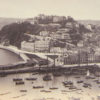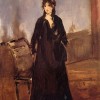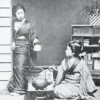
Joseph Viscomi, “William Blake’s 1818 Letter to Dawson Turner and Later Career as Graphic Artist”
Blake printed approximately 157 copies of sixteen illuminated books between 1789 and June 1818. All but fourteen were printed by the end of 1795, by which time Blake had copies of all saleable books in stock and began taking on new “designing and painting” projects. In the twenty-three years between 1795 and 1818, Blake printed illuminated books only four times, for fourteen copies of four titles. In 1818, Blake received an enquiry from Dawson Turner for a “selection” of illuminated designs printed in colors like those Blake had produced for Ozias Humphry in 1796 and which are now known as the Large Book of Designs and Small Book of Designs. Blake refused and redirected Turner to illuminated books and large monoprints, none of which he purchased. Nevertheless, Blake’s letter to Turner marks the moment when Blake was willing to return to a body of work that, with very few exceptions, he had not touched in more than two decades and which he had explicitly declined to reprint in 1808. That decision in 1818, along with a commission from another collector shortly after he wrote Turner, made possible his resurgence in his last decade, as poet, publisher, illustrator, painter, and, equally significant, as original graphic artist. This essay examines Blake’s letter in detail to reveal why he refused Turner’s request, had stopped printing most of his illuminated books, and stopped color printing and monoprinting altogether. It reads the letter closely in light of Blake’s labor history to reveal the idea he had of himself as an artist, the attitude he had toward the hierarchy in the arts, and the works he believed made his “great reputation as an Artist.”

Rebecca Nesvet, “Miss Whitehead, ‘The Bank Nun’”
An urban legend maintains that early in the nineteenth century, one Miss Whitehead, colloquially known as “the Bank Nun,” frequently visited the Bank of England to accuse that institution of destroying her brother, a financial forger. This essay traces the evolution of this legend. I contend that in 1837, an obscure comic sketch reacted to that year’s major financial crisis by dredging up the Romantic-era case of financial forger Paul Whitehead and focusing on his surviving sister. Displacing her brother’s notoriety onto her, the sketch reinvents her as “the Bank Nun,” a grotesque magnet for lingering Romantic-era anxieties about the circulation of paper credit, financial forgery, and women. A succession of plagiarisms, retellings, and reappraisals of this ephemeral sketch and its portrait illustration made the Bank Nun a folk heroine of enduring resonance. Via this iconic figure, Romantic-era economic controversy haunts London today.

Irena Yamboliev, “Christopher Dresser, Physiological Ornamentist”
This article argues that, in 1862, when he published his most influential book The Art of Decorative Design, Christopher Dresser joined the multi-disciplinary enterprise of the physiological aesthetics in the name of ornamental form, positioning the theory of ornament as a crucial cutting edge of the empirical study of human aesthetic responses. I read The Art of Decorative Design in relation to contemporary psychological-aesthetics texts by Alexander Bain, Herbert Spencer, James Sully, Edmund Gurney, and Clementina Anstruther-Thomson and Vernon Lee to show that Dresser finds in ornamental form a site for a materialist physiological understanding of aesthetic response—and he does so well prior to the essays on aesthetics that were published in the journal Mind from the 1870s on. Like contemporary empirical aestheticists—and in distinction to other ornamentists of his time—Dresser emphasizes the mental “laws” that orchestrate our reactions to forms in nature and in ornament alike. Tracing in Dresser’s design handbook an approach to ornamental form that becomes fully “physiologized” in Bain’s, Sully’s, Gurney’s, and Lee’s writing makes more complete the critical picture of the so-called “lesser” (and often pejoratively feminized) decorative arts as a fertile ground for the theories and practices the empirical aestheticists were pursuing.

Troy J. Bassett, “‘More than a Bookseller’: Iredale’s Library as the Center of Provincial Literary Life”
Andrew Iredale welcomed Her Royal Highness Princess Victoria and her cousins to his library in Toquay, Devon on 1 September 1898 where the group bought books and photographs. Founded by Iredale in 1872, Iredale’s Library became the “centre of literary life” in the seaside resort community well into the twentieth century. This article considers the circulating library’s role in the community: in addition to selling and lending books, the library served as a place for public and private meetings, third-party business transactions, and interpersonal networking. As the history of Iredale’s Library illustrates, provincial circulating libraries played a vital role in communities well beyond their money-making operations.

Jill R. Ehnenn, “On Art Objects and Women’s Words: Ekphrasis in Vernon Lee (1887), Graham R. Tomson (1889), and Michael Field (1892)”
Studies of women’s ekphrasis prior to modernism have, so far, tended to focus on individual women writers rather than attempt to identify trends that female authors from a particular time period might share. This essay intervenes in this gap in the scholarship by analyzing ekphrastic prose and poetry by Vernon Lee, Graham R. Tomson, and the co-authors who wrote as Michael Field. As female Aesthetes well-versed in art history and art criticism, as well as contemporary market practices, these nineteenth-century women writers anticipate today’s feminist theorists in the ways in which they were quite conscious of woman’s role as art object and the various functions of that role.
Here I examine Vernon Lee’s somewhat well-known novella Amour Dure (1887) as a foundational case study and then turn to two considerably lesser studied poems: Graham R. Tomson’s “A Silhouette” (1889) and Michael Field’s “Saint Katharine of Alexandria” (1892), for which I also identify the long-lost ekphrastic referent. These three texts all demonstrate how a specific form of aesthetic intertextuality—ekphrastic representational friction—operates as a powerful vehicle for early feminist criticism. In the examples I discuss, gendered critiques drive representational friction between the word, the visual medium, and its original referent—slippages that these art-savvy authors would have easily recognized and had opinions about in the work of others, and intentionally created and/or appropriated in their own work. Importantly, I also argue that a helpful way to think about ekphrastic writing by women writers associated with nineteenth-century British Aestheticism is to consider representational friction with particular regard to how their texts treat objects—seemingly unimportant objects—associated with their subjects.

Elizabeth Berkowitz, “The 1910 ‘Manet and the Post – Impressionists’ Exhibition: Importance and Critical Issues”
“The 1910 ‘Manet and the Post-Impressionists’ Exhibition: Importance and Critical Issues” summarizes both the key historical aspects of the 1910 “Manet and the Post-Impressionists” exhibition, and the historiographic disputes that have arisen in relation to it. This article addresses the degree to which the term and art historical category “Post-Impressionism,” coined for this exhibition, represents a critical construction, rather than a genuine stylistic demarcation. In addition, this article counters the scholarly misperception that the vitriolic response to the 1910 exhibition was a product of British cultural ignorance of late-nineteenth- and early-twentieth-century continental Modern art.

Wendy S. Williams, “‘Free-and-Easy,’ ‘Japaneasy’: British Perceptions and the 1885 Japanese Village”
This essay examines press reviews and accounts of the Japanese Village in London from newspapers and periodicals in 1885. These show that although writers were fairly confident that they “knew” the Japanese culture, they had only a superficial understanding of it, and they often depicted Japanese people as simple, coarse, and inferior. These writings largely reflect British feelings of superiority, enchantment, and confusion regarding Japan, a quickly progressing country that was not easy to classify.

Meaghan Clarke, “1894: The Year of the New Woman Art Critic”
In 1894, satirical journals such as Punch mockingly identified the phenomenon of the New Woman, as found in novels, plays and articles, as an intellectual and independent figure. These mannish representations of professional women seem impossible to reconcile with the aesthetic and fashionable realms of late Victorian art and culture. Studies have frequently considered the role of Victorian women as models or sitters—objects of a male artist’s inspiration. However, other career paths for women were possible. Many women were successful artists and an alternative entrée into the art world was journalism. This article will posit that women art journalists provided a living example of professional opportunities for intellectual New Women. Although their work has been largely left out of accounts of the period, they contributed to key developments in art history at the end of the century. To begin with, I will touch on the history of art writing and its development as a professional avenue for women. Then, I will explore specific themes in order to consider the diversity of their critical responses to contemporary British art circa 1894. This will encompass women’s writings on Pre-Raphaelite and academic artists as “celebrities,” groups influenced by French Impressionism in Newlyn and St. Ives, London Impressionists and Glasgow Boys, as well as art and culture beyond Britain.

Nancy Rose Marshall, “On William Powell Frith’s Railway Station, April 1862″
William Powell Frith’s oil painting, The Railway Station (1862), is an enlightening case study of the pressures and conditions that formed an art viewer in the second half of the nineteenth century in London. A painting of a contemporary urban crowd, displayed for that same crowd in a novel single-picture exhibition, has much to tell us about the emergence of modern structures of seeing and living based on new configurations of money, time, and space.

Julie Codell, “On the Grosvenor Gallery, 1877-90”
The Grosvenor Gallery (1877-90), founded by Sir Coutts Lindsay and Lady Caroline Blanche Elizabeth Fitzroy (a Rothschild on her mother’s side) on 135-37 New Bond Street in London, generated a seismic change in the conventional Victorian art world in its exhibition of then avant-garde artists like Edward Burne-Jones, James McNeill Whistler and G. F Watts, and other leading members of the Aesthetic Movement, such as Frederic Leighton. Its unique methods of display, invitations to exhibit, support of women artists, and stunning building and interior decoration marked its ties to the Aesthetic Movement and its challenge to the Royal Academy.
